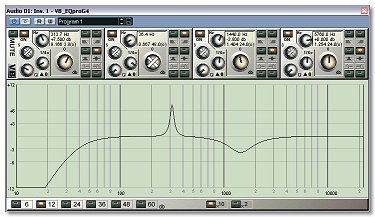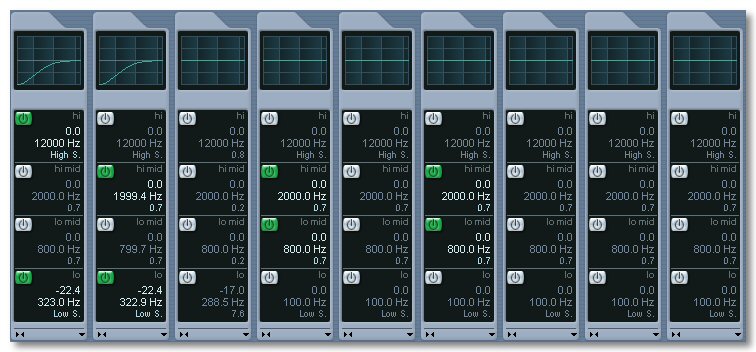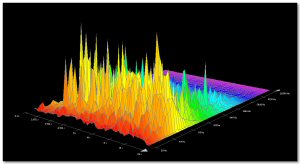This article comes from the wonderful Ziggy's sonorisation site. It is reproduced here, of course, with the kind permission of Ziggy himself ;o) We really advise you to go to this site, where you will find other articles that don't have their place here, especially concerning microphones, mixing boards, amplifiers, etc.
Drums
Bass
Guitar
Voice and others
Mastering
Frequencies
 The equalization enables to influence and to master the sound colour of an instrument or a mix. It is also used to balance a mix, i.e. to help each instrument to find its place in the sound spectrum. During live shows, it is used to avoid feedback, and to impose a certain sound colour, or to attenuate the sound defects of a concert hall.
The equalization enables to influence and to master the sound colour of an instrument or a mix. It is also used to balance a mix, i.e. to help each instrument to find its place in the sound spectrum. During live shows, it is used to avoid feedback, and to impose a certain sound colour, or to attenuate the sound defects of a concert hall.
There are two sorts of EQ:
The graphic EQ, where the frequencies spectrum is cut in a certain number of bands. The more simple is the 2 or 3-band EQ which can be found on guitar amp and radios or small Hi-Fi. A little more sophisticated, still on amps, or on some mixing boards, the 6-band EQ, where six different settings can be found. However, for serious work, 15 bands are needed. The standard in live and studio is 31 bands. We are then talking of a third octave EQ, since very octave is divided in three bands.
The other family is composed of parametric EQ. Here, frequencies and bandwidth are not fixed, but can be freely set. SI, if you want to affect the 1.5kHz and if you only have a 15-band EQ, you will have to choose between the nearest pre-settings, 1kHz in our case, and it will affect the whole frequency range between 500 Hz and 2 kHz. The result won't be the same if you use a parametric EQ and if you set the exact frequency (1.5 kHz) with a sufficiently narrow width in order to affect only frequencies between 1.4 and 1.6 kHz!
Main settings on EQ
Graphic Eq
INPUT - Input level, in order to not saturate the electronic circuits.
LOW CUT - High-pass filter, to make a first filtering (low frequencies will be attenuated under a certain frequency)
HIGH CUT - Low-pass filter, to make a first filtering (high frequencies will be attenuated above a certain frequency). On some models, we can find noise limiter or reducer (dBx 2231)
LEVEL - The input level setting is often replaced by an output level setting in order to correct the gain changes on the modified signal.
(if you increase by 6 dB the 1kHz, the sound volume will almost double!).Then, there are the different cursors or pots to increase or decrease the frequencies.
RANGE - Good quality EQs have a switch to change the maximum setting extent between 6 dB (finer) and 12 dB (more efficient)
BYPASS - It is essential to compare the direct sound and the processed sound.
Parametric EQs
INPUT - Input level, in order to not saturate the electronic circuits.
LOW CUT - High-pass filter, to make a first filtering (low frequencies will be attenuated under a certain frequency)
HIGH CUT - Low-pass filter, to make a first filtering (high frequencies will be attenuated above a certain frequency). On some models, we can find noise limiter or reducer (dBx 2231)
OUTPUT - The input level setting is often replaced by an output level setting in order to correct the gain changes on the modified signal.
(if you increase by 6 dB the 1kHz, the sound volume will almost double!).Then, there are the different cursors or pots to increase or decrease the frequencies.
FREQUENCY - Sets the central frequency
BANDWITH or Q - Sets the width of the band. Numbers refer to octave, 2 means a width of 2 octaves (for 1 kHz the bandwidth goes from 500 Hz to 2 kHz), 0.5 means half an octave (for 1kHz, it goes from 800 Hz to 1.2kHz). But be careful, on some devices, the numbers exactly indicate the contrary, i.e. 2 means half an octave and 0.5 means 1/0.5 = 2 octaves
LEVEL - Set the process gain, generally from -15 to +15 dB
BYPASS - It is essential to compare the direct sound and the processed sound.
Know that in order to make a good equalization work, you must have quality devices! A 90 €uros 15 bands EQ bought in a supermarket is no earthly use. It will only bring noise and distortion!!!
Let's see now some practical examples of use (these propositions are rather arbitrary, the ears will choose at the end!).
Drums
On the Bass Drum, we will try to give a good foundation for the warmth and the woumm, and we will increase the low-medium for the kick which characterize the modern sound.

- Low + 4 to 6 dB at 80 Hz
- Low - 2 to 4 dB at 150 Hz
- Low-medium - 4 to 6 dB at 630 Hz
- Medium + 6 to 10 dB at 3 kHz
On toms, we will attenuate the low-medium which sounds like "ploc" et we increase the low and high harmonics if possible, because some badly set toms resonate a lot in low frequencies, and we must cut these ones to the detriment of the sound.
- Low + 2 to 5 dB at 180 Hz
- Low-medium - 4 to 8 dB at 630 Hz
- Medium + 4 to 6 dB at 2,5 kHz
- High + 2 dB at 5 kHz
On the snare drum, the settings are different depending on what we want to obtain.
Fine Snare Drum (jazz, funk) :
- Low + 2 to 4 dB at 180 Hz
- Low-medium - 4 dB at 630 Hz
- Medium + 4 to 6 dB at 4 kHz
- High + 5 dB at 10 kHz
Medium Snare Drum (funk, dance) :
- Low + 2 to 5 dB at 250 Hz
- Low-médium + 3 to 5 dB at 1,2 kHz
- Medium + 4 to 6 dB at 3 kHz
- High + 2 dB at 10 kHz
Snare Drum (rock, light music) :
- Low + 2 to 5 dB at 200 Hz
- Low-medium - 4 to 8 dB to 630 kHz
- Médium - 2 à 5 dB à 1,5 kHz
- High + 6 dB at 6 kHz
Heavy Snare Drum (rock, heavy) :
- Low + 4 to 10 dB at 230 Hz
- Low-medium - 2 to 5 dB at 500 Hz
- Medium + 2 to 5 dB at 2,5 kHz
- High + 6 dB at 4 kHz
Hi-hats and cymbals (overhead)
- Low - 12 dB à 250 Hz
- Low-medium - 6 dB at 800 Hz
- Medium - 2 dB at 2kHz
- High + 2 to 4 dB at 8 kHz
-
Back to top
Bass
 Increase the low and high harmonics:
Increase the low and high harmonics:
- Low + 2 to 5 dB at 100 Hz
- Low-medium - 3 dB at 800 Hz
- Medium + 2 to 4 dB at 2 kHz
- High - 8 dB at 10 kHz
- Low pass at 8 kHz
Back to top
Electric guitar
I am often confronted with two major problems, especially with saturated guitars. First, the sound is too mat and coated: decrease a little the 400 Hz and increase the 2-3 kHz. Secondly, the sound is too aggressive: attenuate the 2-3 kHz.
Clean sound (funky)
- Low + 4 dB at 250 Hz
- Medium - 4 to 6 dB at 800 Hz
- High + 2 to 4 dB at 4 kHz
Clean sound (blues)
- Low + 4 dB at 250Hz
- Medium + 4 dB at 1,2 kHz
- High + 2 dB at 4 kHz
Saturated sound (blues, lead)
 Low +4 dB at 250Hz
Low +4 dB at 250Hz
- Medium +4 dB at 1,2 kHz
- High + 2 dB at 4 kHz
Saturated sound (modern heavy)
- Low +10 dB at 180Hz
- Medium - 6 dB at 800 Hz
- High + 6 dB at 4 kHz
Acoustic guitar
- Low +4 to 6 dB at 160 Hz
- Low-medium - 4 dB at 500 Hz
- Medium -2 dB at 1,6 kHz
- High + 2 to 4 dB at 6 to 8 kHz
Back to top
Voice
 To attenuate a little the low-medium and increase the high-medium is a good thing to emphasize the voice.
To attenuate a little the low-medium and increase the high-medium is a good thing to emphasize the voice.
- High-pass filter at 100 Hz
- Low + 2 dB at 200 Hz
- Low-medium - 2 to 4 dB at 350 Hz
- Medium + 4 to 6 dB at 2 kHz
- High + 2 dB at 5 kHz
Brass, Woodwinds and Keys
There is often no need to equalize - on saxophones and flutes, we will sometimes attenuate high-medium (2 to 4 kHz).
Back to top
General mix

A complete mix is always very delicate to process, because the signal is very complex. Avoid the "V" setting (i.e. low and high frequencies to the max, medium to zero), it sounds powerful but always makes think of a bad disco sound. Rather try to emphasize the harmonics and to make the colour being more interesting by finding the important frequencies (frequencies which change the sound spectrum as soon as you touch them). To attenuate low medium and increase brightness is often fabulous.
- Low + 3 dB at 80 Hz
- Low-medium - 3 dB at 350 Hz
- Medium - 2 dB at 2 kHz
- High + 2 to 4 dB at 12 kHz
EQ in the mix
The EQ can be useful to balance a mix. If for example we equalize all the instruments with the same settings (low to the max, medium to zero), we will obviously obtain a big "noise". Instead of separately treating the instruments, try to attribute them a place in the mix depending on their colour and frequencies, avoiding too much overlapping in frequencies.
Example : if the bass drum is very heavy and powerful in the 80 Hz, don't do the same for the bass, attenuate the 80 Hz, and increase a slightly higher frequency, 150 Hz for example.
Same thing for the guitar. It doesn't need to have low frequencies to the max, it would only heavy the mix. On the contrary, attenuate the medium around 60 - 800 Hz, the low will automatically sound warmer, and if you increase a little the 2.5 kHz, the guitar will easily place itself on the front line.
Same thing for the voice. Don't put too much low frequencies, otherwise the mix will be coated...
Back to the top
Frequency table

Here is a little referential table, which gives information on the important frequencies of instruments.
| Instruments |
Low-cut |
Fundamental |
Sensitive frequency |
Harmonics |
| These frequencies are obviously given for information only, and have to be refined depending on cases... |
| Male voice |
100 Hz |
200 Hz |
2 kHz (+) |
4 to 5 kHz |
| Female voice |
120 Hz |
300 to 400 Hz |
2,5 kHz |
5 to 6 kHz |
| Spoken voice |
120 Hz |
200 Hz |
2 to 3 kHz |
4 kHz |
| El. guitar |
80 Hz |
200 to 300 Hz |
2,5 kHz |
> 4 kHz |
| Ac. Guitar |
100 Hz |
150 to 250 Hz |
2 to 3,5 kHz |
6 kHz |
| Piano |
- |
80 to 150 Hz |
2 to 3 kHz |
> 4 kHz |
| Harmonica |
100 Hz |
250 Hz |
1,5 to 2,5 kHz |
4 kHz |
| Saxophone |
80 Hz |
150 to 250 Hz |
2 kHz (-) |
3 to 4 kHz |
| Trombone |
80 Hz |
150 Hz |
1,5 kHz |
3 kHz |
| Trumpet |
120 Hz |
300 Hz |
1,5 kHz (-) |
> 4 kHz |
| Flute |
200 Hz |
300 Hz |
1,5 to 2 kHz |
4 kHz |
| Bass |
- |
80 Hz |
250 to 500 Hz |
2 to 3 kHz |
| Bass Drum |
- |
60 to 80 Hz |
350 to 600 Hz (-) |
2 to 3 kHz |
| Snare Drum |
80 Hz |
150 to 250 Hz |
600 to 1,5 kHz |
3 to 5 kHz |
| Tom |
100 Hz |
150 to 200 |
600 (-) |
2 to 3,5 kHz |
| Floor Tom |
- |
120 |
300 to 500 (-) |
2 to 3,5 kHz |
| Hi-Hats/Cymbals |
200 Hz |
400 to 600 Hz |
2 to 3 kHz (-) |
8 kHz |
First, a very important thing: in order to work well on equalisation, a parametric eq is essential!! Thus, on small mixing boards, frequency ranges are often fixed (medium to 2kHz for example). These frequencies are rather well chosen in order to equalize a voice or a guitar, but inappropriate for drums.
The first column gives the frequency of a possible LOW CUT, that is to say the low frequencies which are relatively useless for the instrument sound. Professional mixing board have a low cut (which sometimes can be set, or with a fixed frequency, 100 Hz for example), with which all the useless low frequencies are removed. This considerably lighten the whole mix, and remove many parasitic noises.
The FUNDAMENTAL column gives the frequency on which the instrument is based. Increasing it, we can find immediately warmth and depth; decreasing it, the sound lightens and becomes slighter.
SENSITIVE FREQUENCY is the mainspring frequency of the instrument. It is the critical frequency which will the more influence the sound. Increasing it, the instrument seems louder and will naturally place in front of the mix, but this can quickly become aggressive. Decreasing it, the instrument goes "inside" the mix and the sound softens.
HARMONICS gives the frequencies which are responsible for the colour of the instrument sound. Increasing it, we have the impression of more presence and brightness, decreasing it the sound becomes dull.
|
Back to top
 The equalization enables to influence and to master the sound colour of an instrument or a mix. It is also used to balance a mix, i.e. to help each instrument to find its place in the sound spectrum. During live shows, it is used to avoid feedback, and to impose a certain sound colour, or to attenuate the sound defects of a concert hall.
The equalization enables to influence and to master the sound colour of an instrument or a mix. It is also used to balance a mix, i.e. to help each instrument to find its place in the sound spectrum. During live shows, it is used to avoid feedback, and to impose a certain sound colour, or to attenuate the sound defects of a concert hall.
 Increase the low and high harmonics:
Increase the low and high harmonics: Low +4 dB at 250Hz
Low +4 dB at 250Hz
 To attenuate a little the low-medium and increase the high-medium is a good thing to emphasize the voice.
To attenuate a little the low-medium and increase the high-medium is a good thing to emphasize the voice.
